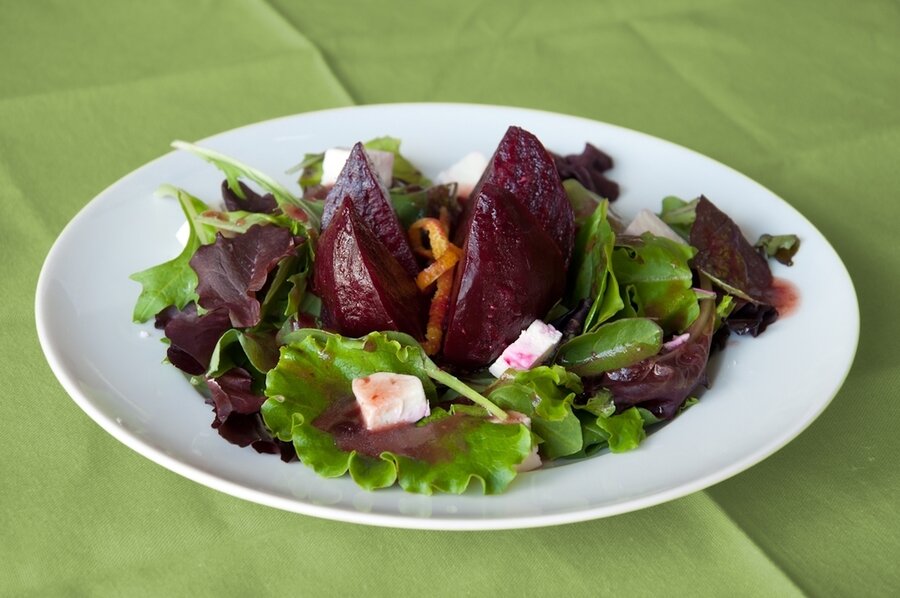How to grow and prepare beets
Southerners have known the goodness of many different kinds of greens for generations. Since I (Anne) grew up “up North,” spinach was the only type of greens I was acquainted with.
One that is grown mainly for its bulbous root over most of the country is the beet. And yet, historically, beets were originally grown for their tops. (If you use heirloom seed, you might be disappointed in the size of the root. Check descriptions carefully when purchasing seed if you want to have large bulbous roots.)
How to grow beets from seed
Beet seed is actually a hard capsule that contains several seeds. If you soak the seed for 24 hours, you will get quicker germination.
Beets need a soft growing area so their roots will mature correctly. Prepare a seed bed deeply in a well-drained area. Add plenty of compost to improve either clay or sandy soils.
Sow the beet seeds 1/2 to 3/4 inches deep, three inches apart, in rows two to three feet apart. Keep the soil moist but not wet.
The most critical thing to do when growing beets is to snip off all but one beet plant seedling so the bulb will have room to grow.
Since beet seed is actually several seeds in a cluster, you have to thin the seedlings by cutting off all but the strongest plant in each planting hole. Do not pull them; you can damage the roots of the plant you want to save.
Begin thinning when seedlings are about four to five inches tall, and eat the thinnings. Thin to three to four inches if you plan to harvest young, small, or cylindrical-shaped roots, or six-inch spacing for larger roots.
Beets tolerate temperatures to 40 degrees F. (4 C), so plant them early in the spring. You can also plant them for a late fall crop.
I love beets and usually eat them boiled or pickled. Chef Linda’s beet salad recipe coming up next is new, different, and delicious.
Recipe: Roasted Beets on Baby Greens with Feta & Raspberry Vinaigrette
My (Linda's) first recollection of beets was from a narrow antique serving dish on the dining room table of my grandmother’s home in Mobile, Ala. The only recipe that she made back then was Harvard Beets, with an orange sauce.
The beets were good, but that was pretty much what you saw on the tables of Southern homes, either Harvard Beets, sliced beets, or pickled beets.
These days there are not only many different ways to prepare beets but different colors of beets as well. Today, I’m giving you a recipe for a red beet salad, but if you want to use orange beets, you sure can. Use what you have.
I hope that you enjoy this recipe. For the recipe for delicious beet greens, please e-mail me through my website and I’ll be happy to send the recipe.
Beet Salad
2 medium beets or 1 large beet per person
6 cups baby salad greens
1 (8-ounce) container Feta cheese
Orange juice and zest
Preheat the oven to 350 degrees F. Clean the beets and spray them with cooking spray. Wrap in foil. Place in an ovenproof dish and bake beets for 45 to 60 minutes, depending on the size. When beets are done or tender, remove from the oven to cool. The peel should slip right off, but if not, then use a knife to peel. Cut each beet into 4 wedges, but don’t cut all the way through so that it will stand on the plate.
Prepare 4 salad plates with 1-1/2 cups baby greens per plate. Place a beet (or two) on each plate in the center of the greens. Crumble feta cheese and distribute among the four plates. Drizzle the beets lightly with orange juice, and then drizzle with raspberry vinaigrette. Zest some orange over the top of each plate. Serves 4.
Raspberry Vinaigrette
1/3 cup seedless raspberry jam or preserves
4 teaspoons rice wine vinegar
4 teaspoons cider vinegar
1 tablespoon white wine vinegar
1 teaspoon Country Dijon mustard
1/4 cup vegetable oil
In a small bowl, mix the preserves, vinegars, and mustard. Slowly drizzle the oil into the dressing while whisking. Store any unused vinaigrette in the fridge.
-----
Linda Weiss and Anne Moore, who blog at Diggin' It about food and gardening (click here to read their previous posts), are friends who met while Linda was the food editor and Anne was the garden editor for South Carolina Homes & Gardens magazine. They now write articles for the ETV GardenSMART television show website, where Anne is the horticulture editor, gardening consultant, and e-newsletter editor. Anne has written for magazines and newspapers. She is a member of and a recipient of a Silver Award for magazine writing from the Garden Writers Association. Linda is a personal chef. She attended Le Cordon Bleu of Paris’ catering program. She has appeared as a guest chef on numerous television shows, has been a culinary educator for 10 years, and a food writer for a number of magazines. She is a professional member of The James Beard Foundation and the Southern Foodways Alliance. She has written a cookbook, "Memories From Home, Cooking with Family and Friends."






